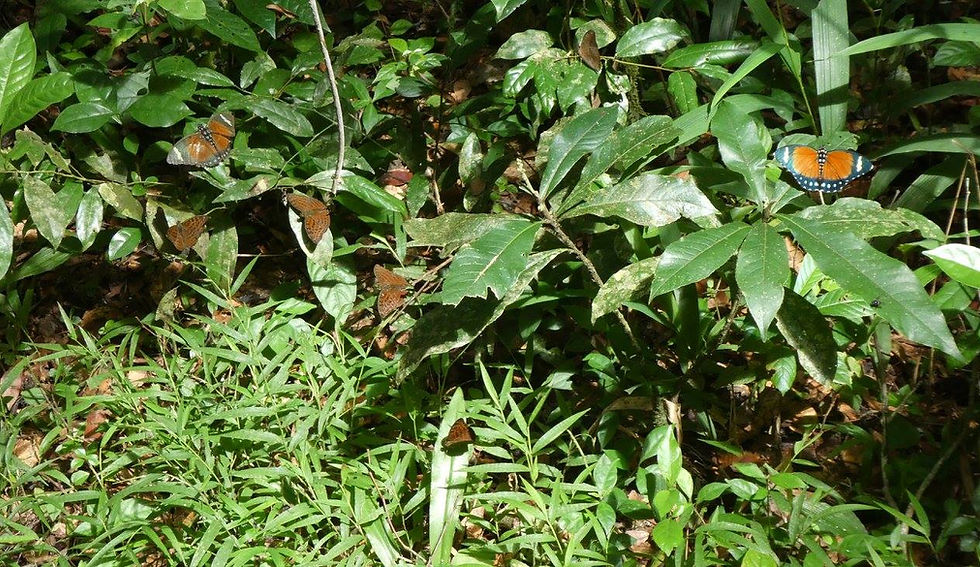Subfamily Heliconiinae.: A largely pantropical group, with one of the five tribes found in the Holarctic Region.
Tribe Acraeini: There are two Afrotropical genera contained within this tribe; Telchinia and Acraea, both represented at Semuliki. There are 138 described Afrotropical species within this tribe with 104 species recorded in Uganda. At Semuliki a total of 45 species from both genera have been recorded: 25 from the genus Telchinia and 20 species of Acraea, contributing to a third of the Ugandan species total.
Genus Cymothoe: There are 15 species of the Afrotropical genus Cymothoe so far recorded at Semuliki from a.continent total of 78 (Williams, 2018) and a Ugandan total of 17 (Williams, 2015) or 90% of Uganda's total. The two Ugandan species not being recorded at Semuliki being C. distincta and C. indamora, but with both these species being recorded either in the Ituri Forest or Semliki Valley (Ducarme, 2018) it is a distinct possibility that they will also be found in Semuliki. Only three species are frequently sampled in traps and these are C. sangaris, C. cyclades and C. confusa. This genus has been categorised into clades nd the most commonly trapped species C. confusa had a distinctly clumped distribution within Semuliki. Species from this genus were observed more in the forest midstorey as compared to the preference of the forest floor for the genera Bebearia, Euphaedra and Euriphene.
Genus Cymothoe: There are 15 species of the Afrotropical genus Cymothoe so far recorded at Semuliki from a.continent total of 78 (Williams, 2018) and a Ugandan total of 17 (Williams, 2015) or 90% of Uganda's total. The two Ugandan species not being recorded at Semuliki being C. distincta and C. indamora, but with both these species being recorded either in the Ituri Forest or Semliki Valley (Ducarme, 2018) it is a distinct possibility that they will also be found in Semuliki. Only three species are frequently sampled in traps and these are C. sangaris, C. cyclades and C. confusa. This genus has been categorised into clades nd the most commonly trapped species C. confusa had a distinctly clumped distribution within Semuliki. Species from this genus were observed more in the forest midstorey as compared to the preference of the forest floor for the genera Bebearia, Euphaedra and Euriphene.

BUTTERFLY
Research, Conservation and Education
Semuliki National Park, Uganda
Genus Euriphene: There have been five species of the genus Euriphene so far recorded from Semuliki. E. doriclea has been reported from Semuliki (Williams, 2022), although it has never been sampled in the fruit-feeding traps and was not included in the checklist publication (Forbes, 2018 ). It has been recorded from the DRC Semliki Valley and the Ituri Forest of the DRC (Ducarme, 2018). These five species contribute to around 40% of Uganda's 12 Euriphene species total, although E. barombina (included in the Davenport Uganda checklist) was recorded in error. E. saphirina (found at Semuliki) replaces E. barombina within the Congo Basin and comprises the species at the eastern extent of its range distribution. The occurrence of three of the species; saphirina, ribensis and atossa in traps was uncommon while only one specimen, a female E. amaranta, has been observed in flight and never sampled in traps. All five species of Euriphene recorded at Semuliki are environmentally sensitive and thrive in forests with good canopy cover and in good condition (undegraded). Taxonomic classification follows Hecq (2002) - see reference below.
Subgenus Doricleana.
This comprises only three species and is not subdivided into groups, unlike the following subgenus. Only one species has been recorded from Semuliki, Euriphene doriclea. There are two subspecies described and the recorded subspecies from Semuliki is E. doriclea infuscata. No images from the field are available as it has yet to be trapped or observed.
Euriphene doriclea ducarmei (Hecq, 1994)
Euriphene doriclea (waiting on field images)
Subgenus Euriphenaria.
This comprises seven groups, with a single species recorded from Semuliki within three different groups (goniogramma, atossa and barombina.
Goniogramma species group. Comprising 11 species with Euriphene ribensis being the sole species recorded from Semuliki.
Euriphene ribensis (Ward, 1871)
-ink.jpeg)
-ink.jpeg)
Euriphene ribensis (male, upper and underside)
-ink.jpeg)
Euriphene ribensis (female, upperside)
-ink.jpeg)
Euriphene ribensis (female, underside)
Atossa species group. Comprising three species with Euriphene atossa being the sole species recorded from Semuliki.
Euriphene atossa (Hewitson, 1865)
-ink.jpeg)
-ink.jpeg)
Euriphene atossa (male, upper and underside)
-ink.jpeg)
Euriphene atossa (female, upperside)
-ink-ink.jpeg)
Euriphene atossa (female, underside)
Barombina species group.
This is divided into three subgroups, two of these subgroups include a single species recorded from Semuliki.
Amaranta subgroup. Comprising 19 species, with Euriphene amaranta being the sole species recorded from Semuliki. A specimen from Semuliki was photographed from The University of Glasgow Museum.
Euriphene amaranta (Karsch, 1894)

Euriphene amaranta (waiting on field images)
Euriphene amaranta (males, left)
Veronica subgroup. Comprising 21 species, with Euriphene saphirina being the sole species recorded from Semuliki. There are four described subspecies, E. saphirina saphirina being recorded from Semuliki.
Euriphene saphirina saphirina (Karsch, 1894)

-ink.jpeg)
Euriphene saphirina (male, upper and underside)
%20(1)-ink.jpeg)
-ink%20(1).jpeg)
Euriphene saphirina (female, underside)
Euriphene saphirina (female, upperside lighter form found at its eastern range limit)
Euriphene saphirina (female, upper and underside - colour and pattern variation)
Z-ink_edited.jpg)
Z-ink.jpeg)
%20(2)-ink.jpeg)
Euriphene saphirina (female upperside, dark form found in Congo Basin specimens)
a-inkb.jpeg)
Euriphene saphirina (female upperside, narrow subapical band)
Genus references and bibliography:
Hecq, J., (2002). Euriphene, Nymphalidae VI (part 15) and Supplement 5. Butterflies of the World. Bauer, E. & Frankenbach, T. eds. Goecke and Evers, Keltern, Germany. Available from www.insecta.de and www.goeckeevers.de.
Nymphalidae.Net provides a detailed taxonomic overview of the Tribe Adoliadini. (Wahlberg, N).
Savela, M. Euriphene Boisduval,[1847], Lepidoptera and Some Other Life Forms. Excellent online resource.
Williams, M.C., (2018). Genus Euriphene. A section of Afrotropical Butterflies (17th Edition). Publication is available from Lepidopterists' Society of Africa website https://www.lepsocafrica.org/?p=publications&s=atb.